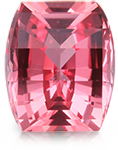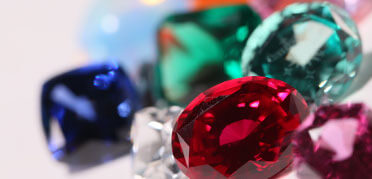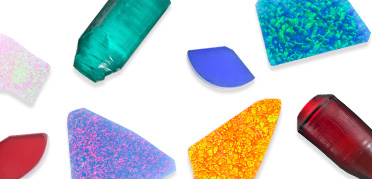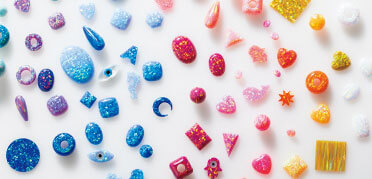Jewelry Glossary
-
P
-
Padparadscha Sapphire
There is no common definition in the world for padparadscha sapphire.
The color is in between a ruby and orange sapphire. The color would be best described as a beautiful pinkish orange.
Padparadscha means "lotus flower" in Sri Lanka. Many padparadscha sapphires are heat treated to have their color improved.
Only gemstones that achieve an aurora red color—a delicate balance between orange and pink—are worthy of being called Crescent Vert padparadscha.
Please clickhere
to learn more about Kyocera's Crescent vert padparadscha sapphire.
[Moh's hardness: 9] [Mineral type: Corundum]
Padparadscha

Called the King of Sapphires, padparadscha is found only in Sri Lanka. Its name means "the morning glow of the Indian Ocean." Padparadscha sapphire is a very rare gemstone. Its remarkable pinkish-orange color evokes dignity and mercy.
Padparadscha sapphire, blue sapphire and ruby all originate from a mineral called corundum. Only gemstones that achieve an aurora red color—a delicate balance between orange and pink—are worthy of being called Crescent Vert padparadscha.Available in sizes up to 10 carats.* If you need a larger stone, please contact us.View Comparison Table Item Crescent Vert Padparadscha Natural Padparadscha Chemical Composition Al2O3 Al2O3 X-ray Diffraction Same as natural stone A pattern specific to Padparadscha Spectroscopic Analysis Same as natural stone Specific absorption of Padparadscha Crystal system Hexagonal Hexagonal Mohs Hardness 9 9 Specific Gravity 4.01 3.90~4.01 Melting Point 2050℃ 2050℃ Transparency Transparent Transparent Refractive Index 1.762~1.770 1.760~1.768 Double Refraction 0.008 0.008 Average Dispersion 0.018 0.018 Pleochroism Orange, Pinkish orange, Yellowish orange Orange, Pinkish Orange, Yellowish orange Chelsea Color Filter Examination Red Red Palladium
Palladium is usually used as an alloy metal, and its specific gravity is half of that of platinum.
Paraiba Tourmaline
Paraiba tourmaline features bright blue or green that is not found in conventional tourmaline. This is derived from its content of copper. It is produced in a wide range of hue phases from green to blue with medium brightness, but neon blue is the most popular.
Paraiba tourmaline is named after a state in Brazil. It was produced on a full-scale for just one year in 1989, but was hardly produced after that.
The depth of the mine is about 60 meters, it was a labyrinth-like system of tunnels extending for kilometers.
It is also produced in Rio Grande de Norte, Brazil; and both Mozambique and Nigeria, Africa and Nigeria. Nowadays, tourmaline containing a trace amount of copper is all called paraiba tourmaline.
[Moh's hardness: 7] [Mineral species: Tourmaline]Pave Setting
Pave, from the French word for “paving stone,” is a setting in which melee gemstones are spread all over a surface.
Pavilion
The pavilion is the lower part of a girdle of loose stones. Please kindly refer to the image of the brilliant cut for details.
Pearl Necklace
Pearl necklaces are named according to their length as follows.
Matinee: approx. 53cm (approx. 21inch)
Choker: approx. 36cm (approx. 14inch)
Princess:approx. 41cm (approx. 16inch)
Opera: approx. 71cm (approx. 28inch)
Rope: approx. 107cm (approx. 42inch)
Long rope: approx. 142cm (approx.56inch)
There are also various names according to different designs, such as convertible, lace, twist, combination and cocktail.Pear-shaped Cut
A pear-shaped cut, as the name suggests, is shaped like a pear fruit.
The long type, which has an aspect ratio of 1.7 to 1.0 or 1.6 to 1.0, is called "drop shaped" whereas the thicker type is called "pear shaped."Per
In the case of melee-size gemstones such as melee diamonds, "per" (pieces per carat) is also often used as a unit.
Usage examples include "50 Per Melee," or "100 Per Melee." 50 per melee means 1/50ct, which means 0.02ct.
100 per melee means 1/100ct (0.01ct).
Also, there is "10 per," which means 0.1ct.Peridot
The origin of the word of "peridot" is olive in Latin and the color is close to olive green. The double refractive rate of peridot is high and the ridge line on the girdle side looks double from the facet cut table side (upper side). If it is used for a ring, it is recommended to polish into a cabochon cut and facet cut is recommended for pendant considering the hardness. It is said that high transparency, and not brownish, pieces are better.
[Moh's hardness: 6] [Mineral type: Olivine]Pigeon Blood
Its deep red color is considered an ideal color for a ruby. It can't be too dark or too light to sell it as a pigeon blood color. During their long history, pigeon blood rubies were considered to be mysterious by their rareness, and have been highly appraised in the jewelry market around the world.
Pink Diamond
Color is the most important characteristic for a pink diamond, pay close attention that it is not brownish pink. The origin of the pink coloration is not from micro mine components, but rather due to distortions of crystal structure.
There are two main types of sought after pink diamonds.
One is the Australian argyle diamond type.
The features of Australian argyle diamond are smaller and purplish pink.
The other is relatively large and light pink in color. India and Brazil are historic producing areas but currently, main sources are the carinan mines in South Africa (formerly known as premiere mine), Tanzania, Zaire, Angola, Russia (Arche shell Mining), etc.
The supply of pink diamonds is very limited and expensive so lager sizes are limited and most of them are reflux items.
[Moh's hardness: 10] [Mineral species: Diamond]Pink Topaz
Pink topaz is also known as rose topaz. It turns pink after heat treatment, non-treated stones are very rare. The darker the orange color it displays the more it tends to react to heating which translates to more intense pink hues. Pink topaz from Pakistan features a little purplish while untreated. Pink topaz is considered to be high quality when the color is deep with no traces of brown hues.
[Moh's hardness: 8] [Mineral species: Topaz]Pink Tourmaline
Please refer to the "rubelite."
Pinky Ring
The pinky ring is a ring for the little finger and usually worn by ancient religious leaders, because the little finger was a symbol of chance and secret. Since the little finger is the outermost finger, many rings are designed with the side part of the ring as the main point. In addition, there are many wide designs as the little finger has fewer knots and the ring tends to come off easily.
Pipe Prong
A pipe prong is used to set a round melee.
This prong looks similar to a small-sized crown setting.Placer Deposit
A placer deposit is an accumulation of rough stones that separated from its host rock due to weathering and corrosion from transported by river currents. In Sri Lanka, where a large portion of the world's corundum originates, rough stones of ruby and sapphire are mainly collected from placer deposits.
Platinum
Mainly produced in South Africa, Russia, and Canada, platinum is the most popular metal in Japan, and it is mainly used for bridal rings.
It is a ductile and malleable heavy metal and is resistant to corrosion.Play of Color
It is a unique iridescent effect that makes it look as if various colors such as blue, green, red, and purple are shimmering together in the gemstone.
Pleochroism
Pleochroism is a property that can be seen in the crystals with double reflection. We can see multiple colors in a gemstone depending on the angle when the gem has this property. It occurs with the difference in absorption of two rays in the crystal.
Point
A point is a unit of weight for gemstones to indicate a smaller number of carat. 1ct = 100 point, so 1 point means 2mg (0.01ct).
Polishing
There are several polishing methods, which can be roughly divided into the following categories; traditional polishing by hand, and buff polishing which is currently popular.
Posy Ring
Posy ring is a ring sculpted with poetry or short texts engraved on the surface or inner surface of the ring. It was very popular in Europe from the 13th to the end of the 18th century. It is often given to lovers as a birthday or anniversary gift.
Precious Metal
"Precious metal" is a small amount of production and rare materials. The characteristics of precious metals are "highly corrosion-resistant" and "beautiful appearance." Also, precious metal is very soft and easy to form when producing.
The eight types are as follows.
Gold, silver, platinum, palladium, rhodium, iridium, ruthenium, and osmium, but not all can be used for jewelry.Precious Opal
Precious opal is a generic name for opals that show the play of color effect.
Precious Stone
A precious stone is a stone that is precious with moh's hardness of 7 or greater and is relatively expensive, such as diamond, ruby, sapphire, emerald, and alexandrite.
Precipitation
Precipitation is a production method of lab-grown opal. This process was developed in 1972 in France by Dr. Pierre Gilson. Silica particles in water are settled over a long period; then after solidification, we can see the effect of "play of color."
Kyocera grows opal applying this process and our know-how.
Prehnite
Prehnite is named after a Dutch soldier Hendrik Phone Plane who first discovered this mineral in South America in 1788. These gemstones are mined in semi-transparent pale green like muscat, so they are often polished to cabochon cut and tumble cut.
[Moh's hardness: 6] [Mineral species: Prehnite]Princess Cut
The princess cut mixes the square shape and the brilliance of the brilliant cut.
It was commercialized in the late 1970s. This cut became very popular in the late 20th century for its attractive name. It is also highly efficient in the polishing process because it allows rough stones to be used efficiently. For example, if you cut and polish a 2.0ct raw stone to brilliant cut, it will become 0.7ct. But if you choose the princess cut, it will become 1.0ct. However there is a drawback that the corners can be easily chipped.Prong
A prong is a tool used for stone setting. There are many types of prongs.
Prong Setting
The prong setting is one of the most orthodox styles of stone setting. Gemstones are fixed by various types of prongs.
(Examples)
・For bigger gemstones: square prong, crown setting, sack-type prong, ogre prong, eagle prong, triangular prong, and milk crown prong.
・For smaller gemstones: wire prong and pipe prong.Proportions
It is a gem dimension ratio. Proportion affects the gemstone's brightness and beauty.
Pt 950
Pt 950 is made of 95% platinum and 5% alloy metals.
Alloy metals usually use palladium, copper, ruthenium, cobalt, and iridium, but the choice depends on the country/producers.Pyrope Garnet
Pyrope garnet takes its name from "pyropes" meaning fire in Greek. Its color is derived from rom and iron and it features deep red. Since most pyrope is dark, when polishing, the table surface should be large and the crown thin to prevent stones from becoming too dark. The pyrope is mostly small with few exceeding 2ct sizes. They used to be cut to a small grain for making a ring or a brooch. Small pyropes were often used for jewelry in the 19th century featuring a fiery red color. Since it was mainly produced in the Bohemian region in Czech Republic from the 16th century to the 19th century, it is also called Bohemian garnet.
[Moh's hardness: 7] [Mineral species: Pyrope garnet]Gemstones
-




